Numerical Investigation of Heat-Insulating Layers in a Cold Region Tunnel, Taking into Account Airflow and Heat Transfer
Abstract
:1. Introduction
2. Temperature Field Coupling Theory (Airflow to Lining/Heat-Insulating Layer to Surrounding Rock)
2.1. Theory of Airflow Temperature Field in Tunnel Based on Turbulence Equation
2.2. Analytical Theory for Temperature Fields of Tunnel Lining and Surrounding Rock
3. Field Test of the Dege Tunnel
4. Numerical Analysis of Dege Tunnel
4.1. Model Description
4.2. Model Validation
5. Parametric Study
5.1. Temperature Characteristics of Airflow inside Tunnel under Ventilation Condition
5.2. Temperature Characteristics of Tunnel Lining and Lane Plate under Ventilation Conditions
5.3. Temperature Characteristics of Surrounding Rock under Different Ventilation Conditions
6. Heat-Insulating Layer Design Considerations
6.1. Mechanical Ventilation Velocities (Using FLOLIC Material)
6.2. Heat-Insulating Materials (with Mechanical Ventilation Velocity of 5 m/s)
7. Conclusions
- (1)
- According to the field test results, the proposed design parameters of the heat-insulating layer for the Dege tunnel can meet the anti-freezing requirement. And the accuracy of the proposed numerical model is verified by using the field test data, with the numerical results showing consistency with the field test results in terms of the curve trend and the data magnitude.
- (2)
- The monthly average temperature contours of the airflow in the tunnel are parabolic curves, with the temperature gradient being larger in the near-wall regions while smaller in the tunnel center. The airflow outside the tunnel requires a longer time to reach the same airflow temperature after applying the heat-insulating layer, when compared with the case having no heat-insulating layer. Furthermore, the heat-insulating layer prevents the heat transferring from the surrounding rock to the airflow in cold months (from January to March and from October to December), which plays a role of heat preservation. On the other hand, the heat-insulating layer prevents the heat transfer from the airflow to the surrounding rock in warm months (from April to September), which plays a role of thermal insulating.
- (3)
- After applying the insulating layer made of the FLOLIC material, the monthly average temperatures above the lane plate are always positive even in the coldest month, and the temperature gradient becomes smaller. Attaching the insulating layer to the lining wall would not protect the lane plate and the tunnel springing from damages from frost. The surface temperatures at different locations in the same tunnel cross-section from the lowest to highest points are at the center of lane plate, the tunnel vault, the tunnel spandrel and the tunnel springing, respectively.
- (4)
- The monthly average temperature of the surrounding rock increases by increasing the depth towards into the surrounding rock, while the temperature gradient decreases by increasing the depth towards into the surrounding rock. The variation phase is delayed and the variation amplitude is reduced. After reaching a certain depth, there only appears to be a very small change in the temperature of the surrounding rock. The size of the negative temperature region and the range of the temperature variation in the surrounding rock were both reduced after applying the heat-insulating layer.
- (5)
- By increasing the thickness of the heat-insulating layer, the temperature at the end of the heat-insulating layer on the secondary lining surface drops more significantly which usually increases the length of the lining section of negative temperature region. However, the lining section with a negative temperature at the tunnel ends becomes longer when a thinner heat-insulating layer is applied. Thus, the design thickness of the heat-insulating layer needs to take into account the influence of tunnel ventilation. The temperature of the secondary lining surface drops slightly by increasing the mechanical ventilation velocity, but the design thickness is not affected with the mechanical ventilation condition.
- (6)
- After applying the heat-insulating layer, lining sections with a negative temperature are observed near the two ends of the heat-insulating layer. It means that the heat-insulating layer should be extended at the tunnel entrance and the exit. When considering tunnel ventilation, the design length of the heat-insulating layer should be more than 1.5 times longer than the length with negative temperature at the entrance/exit. When the velocity of mechanical ventilation is increased, the design length of heat-insulating layer should be increased accordingly.
- (7)
- The design thickness and length vary when using different heat-insulating materials. In the case with the same thickness, the material with better heat-insulating performance has to be of a longer length compared to the normal material. Thus, using a material with relatively poor thermal insulating performance to satisfy the anti-freezing requirement would be helpful to reduce construction budgets and receive better economic benefits.
Acknowledgments
Author Contributions
Conflicts of Interest
References
- Kawamura, T.; Mikami, T.; Fukumoto, K. An estimation of inner temperatures at cold region tunnel for heat insulator design. Struct. Eng. Symp. 2008, 54, 32–38. [Google Scholar]
- Tan, X.; Chen, W.; Yang, D.; Dai, Y.; Wu, G.; Yang, J. Study on the influence of airflow on the temperature of the surrounding rock in a cold region tunnel and its application to insulation layer design. Appl. Therm. Eng. 2014, 67 (Suppl. 1–2), 320–334. [Google Scholar] [CrossRef]
- Song, H.; Ye, C.L.; Mi, J.F. Numerical analysis of optimization design for insulation layer in cold regions tunnel. Adv. Mater. Res. 2014, 1065–1069, 368–372. [Google Scholar] [CrossRef]
- Qi, P.; Zhang, J.; Mei, Z.R.; Wu, Y.X. Study on the range of freeze-thaw of surrounding rock from a cold-region tunnel and the effects of insulation material. Adv. Mater. Res. 2011, 399–401, 2222–2225. [Google Scholar] [CrossRef]
- Comini, G.; Del Guidice, S.; Lewis, R.W.; Zienkiewicz, O.C. Finite element solution of non-linear heat conduction problems with special reference to phase change. Int. J. Numer. Methods Eng. 1974, 8, 613–624. [Google Scholar] [CrossRef]
- Lee, K.B.; Howell, J.R. Theoretical and experimental heat and mass transfer in highly porous media. Int. J. Heat Mass Transf. 1991, 34, 2123–2132. [Google Scholar]
- Bronfenbrener, L.; Korin, E. Kinetic model for crystallization in porous media. Int. J. Heat Mass Transf. 1997, 40, 1053–1059. [Google Scholar] [CrossRef]
- Mottaghy, D.; Rath, V. Latent heat effects in subsurface heat transport modelling and their impact on palaeotemperature reconstructions. Geophys. J. Int. 2006, 164, 236–245. [Google Scholar] [CrossRef]
- Lai, Y.M.; Wu, Z.W.; Zhu, Y.L.; Zhu, L.N. Nonlinear analysis for the coupled problem of temperature, seepage and stress fields in cold-region tunnels. Tunn. Undergr. Space Technol. 1998, 13, 435–440. [Google Scholar] [CrossRef]
- Zhang, X.F.; Lai, Y.M.; Yu, W.; Zhang, S. Non-linear analysis for the freezing—Thawing situation of the rock surrounding the tunnel in cold regions under the conditions of different construction seasons, initial temperatures and insulatings. Tunn. Undergr. Space Technol. 2002, 17, 315–325. [Google Scholar] [CrossRef]
- Zhang, X.F.; Lai, Y.M.; Yu, W.; Wu, Y. Forecast analysis for the re-frozen of Feng Huoshan permafrost tunnel on Qing-Zang railway. Tunn. Undergr. Space Technol. 2004, 19, 45–56. [Google Scholar] [CrossRef]
- Tan, X.; Chen, W.; Tian, H.; Cao, J. Water flow and heat transport including ice/water phase change in porous media: Numerical simulation and application. Cold Reg. Sci. Technol. 2011, 68, 74–84. [Google Scholar] [CrossRef]
- Tan, X.; Chen, W.; Wu, G.; Yang, J. Numerical simulations of heat transfer with ice-water phase change occurring in porous media and application to a cold-region tunnel. Tunn. Undergr. Space Technol. 2013, 38, 170–179. [Google Scholar] [CrossRef]
- Mai, J.T.; Chen, C.G. Influence of atmospheric temperature and airflow speed on temperature in Qinling tunnel. J. Shijiazhuang Railw. Inst. 1998, 11, 6–10. (In Chinese) [Google Scholar]
- He, C.X.; Wu, Z.W.; Zhu, L.N. Analysis of freeze- thaw condition in the surrounding rock wall of the Dabanshan tunnel in the Qilian mountains. J. Glaciol. Geocryol. 2000, 22, 113–120. (In Chinese) [Google Scholar]
- Barrow, H.; Pope, C.W. A simple analysis of flow and heat transfer in railway tunnels. Int. J. Heat Fluid Flow 1987, 8, 119–123. [Google Scholar] [CrossRef]
- Barrow, H.; Pope, C.W. Theoretical global energy analysis for a railway tunnel and its environment with special reference to periodic temperature change. In Proceedings of the 7th International Symposium on the Aerodynamics and Ventilation of Vehicle Tunnels, Brighton, UK, 27–29 November 1991; pp. 267–280. [Google Scholar]
- Liu, J.X.; Zhang, X.F.; Li, G.H.; Ma, X.C.; Fu, G.Y. Study on the Effects of Air Temperature Distribution by Flow State inside Cold Region Tunnel. Appl. Mech. Mater. 2012, 170, 1455–1462. [Google Scholar] [CrossRef]
- Zhou, X.; Zeng, Y.; Fan, L. Temperature field analysis of a cold-region railway tunnel considering mechanical and train-induced ventilation effects. Appl. Therm. Eng. 2016, 100, 114–124. [Google Scholar] [CrossRef]
- Tan, X.; Chen, W.; Wu, G.; Yang, J. Study of airflow in a cold-region tunnel using a standard k-ε turbulence model and air-rock heat transfer characteristics: Validation of the CFD results. Heat Mass Transf. 2013, 49, 327–336. [Google Scholar] [CrossRef]
- Lacasse, D.; Turgeon, E.; Pelletier, D. On the judicious use of the k – ε model, wall functions and adaptivity. Int. J. Therm. Sci. 2004, 43, 925–938. [Google Scholar] [CrossRef]
- Bonacina, C.; Comini, G.; Fasano, A.; Primicerio, M. Numerical solution of phase-change problems. Int. J. Heat Mass Transf. 1973, 16, 1825–1832. [Google Scholar] [CrossRef]
- Zhang, Z.R. Heat Transfer; Higher Educational Press: Beijing, China, 1989; pp. 133–134. [Google Scholar]
- Lai, Y.M.; Zhang, X.F.; Yu, W.B.; Zhang, S.J.; Liu, Z.Q.; Xiao, J.Z. Three-dimensional nonlinear analysis for the coupled problem of the heat transfer of the surrounding rock and the heat convection between the air and the surrounding rock in cold-region tunnel. Tunn. Undergr. Space Technol. 2005, 20, 323–332. [Google Scholar]
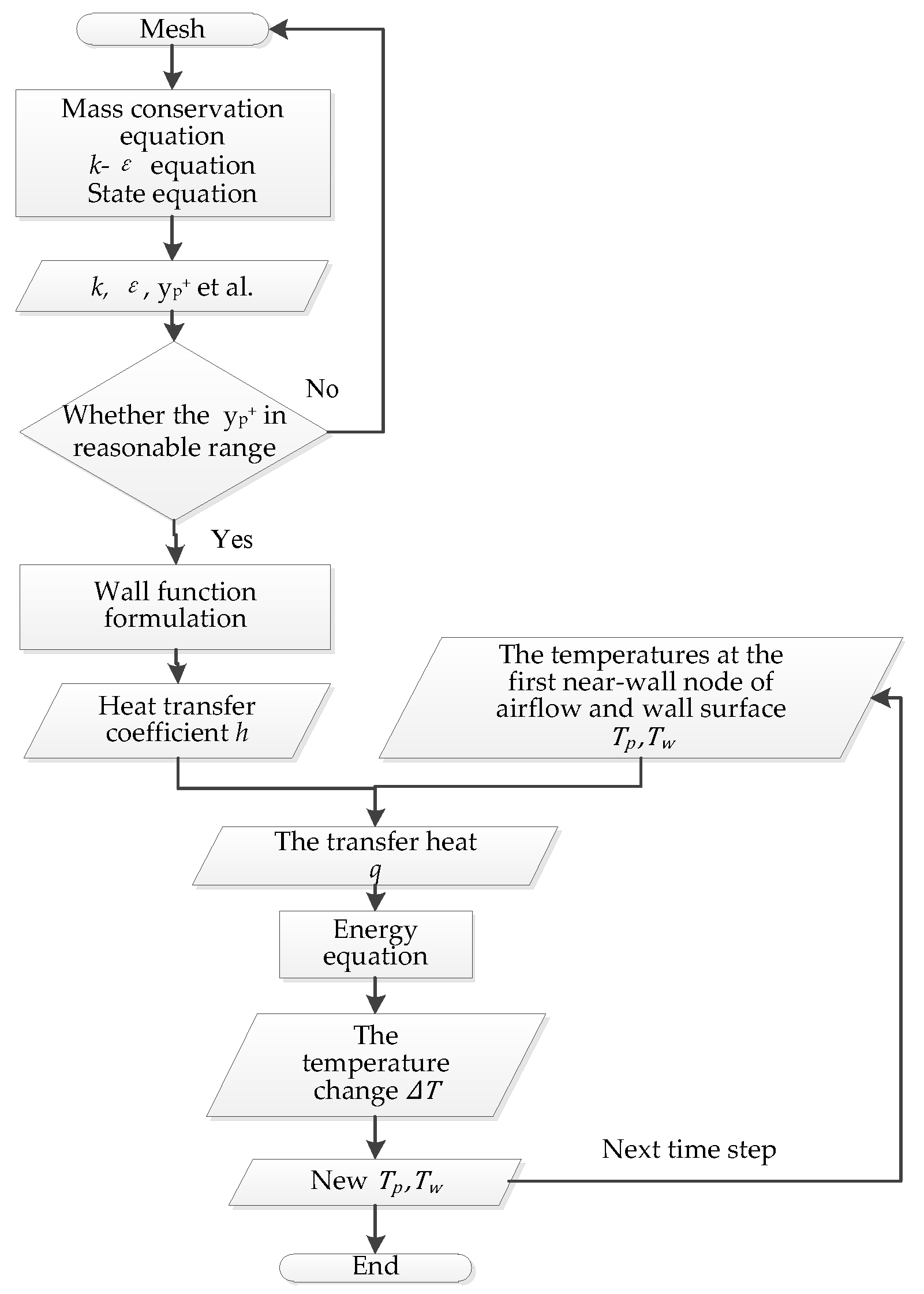
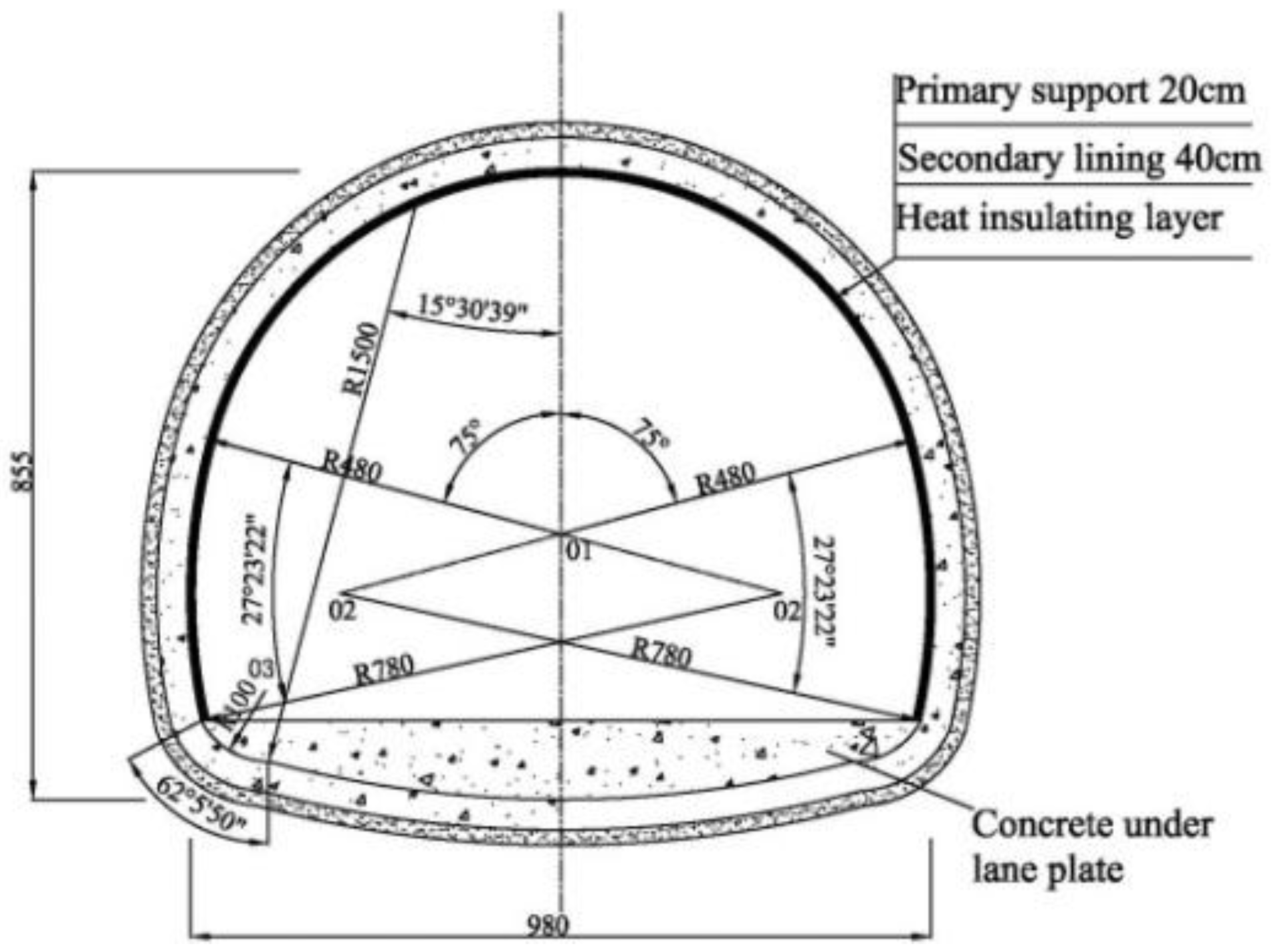

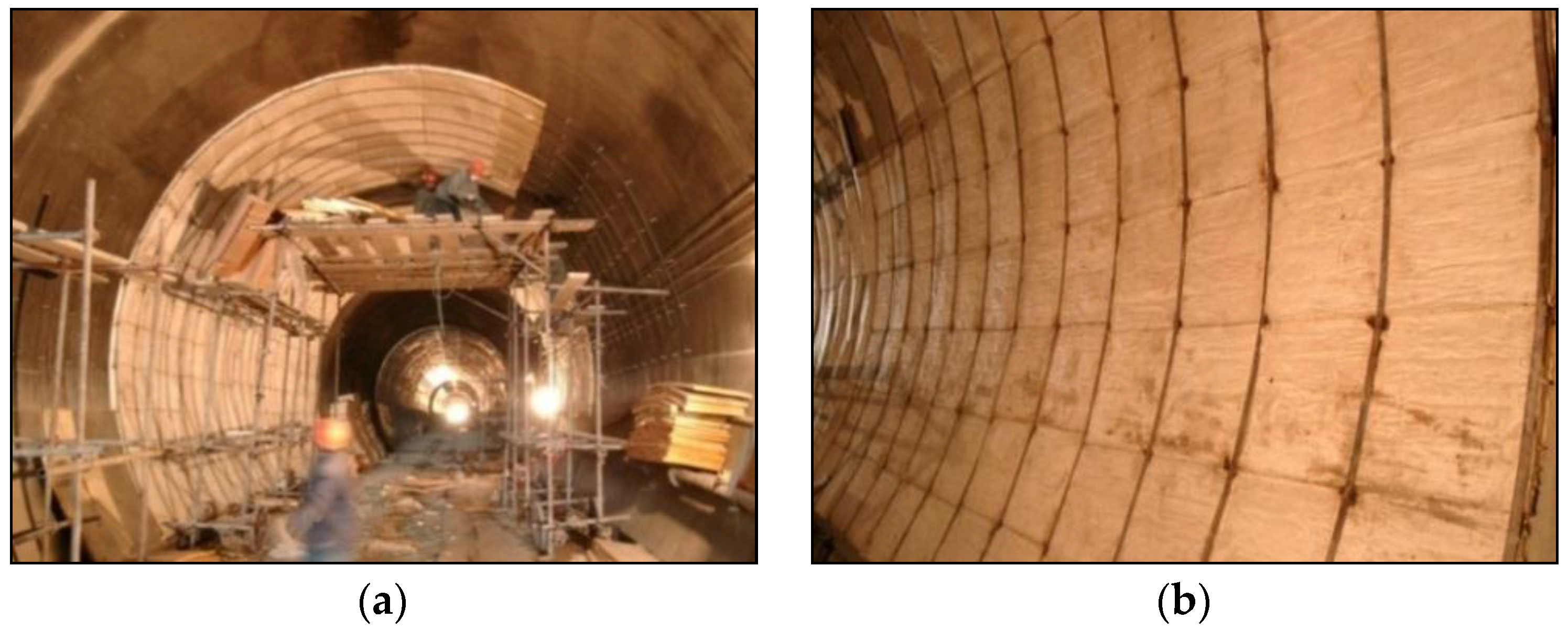
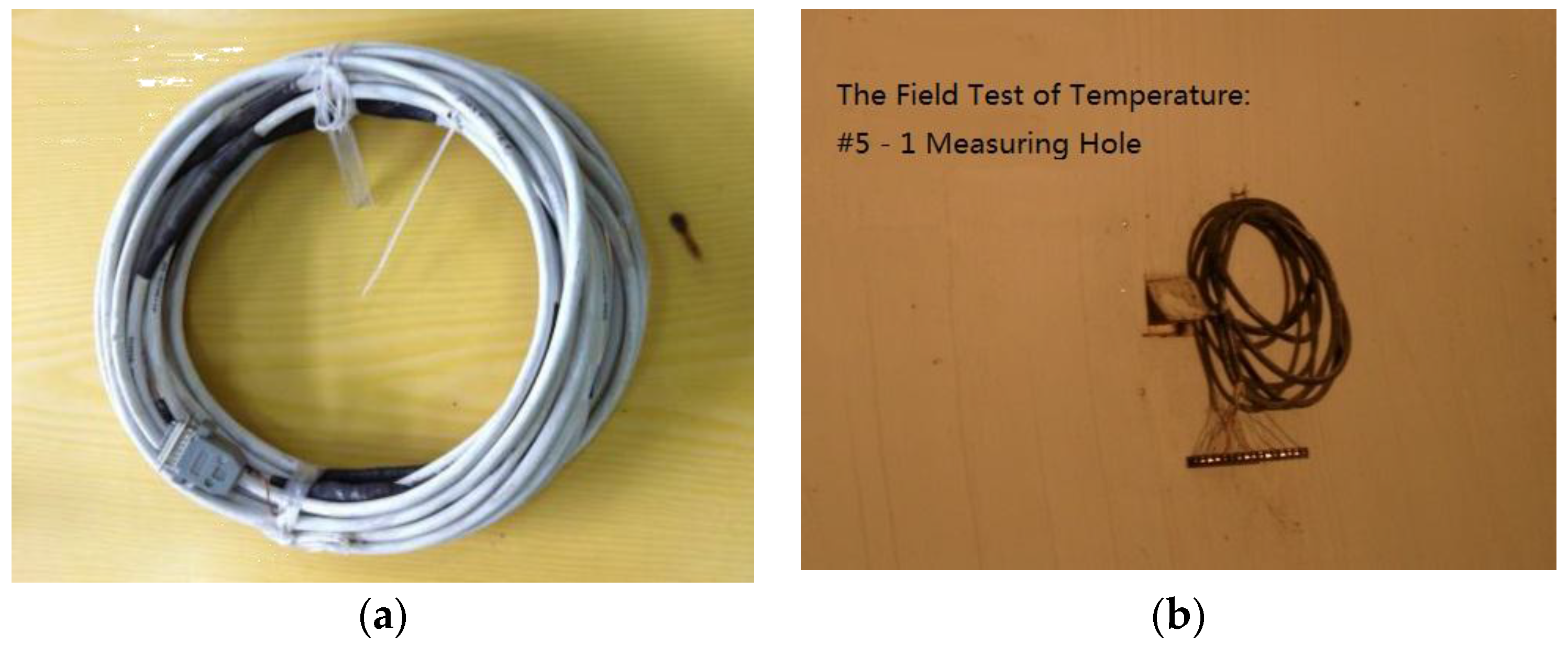
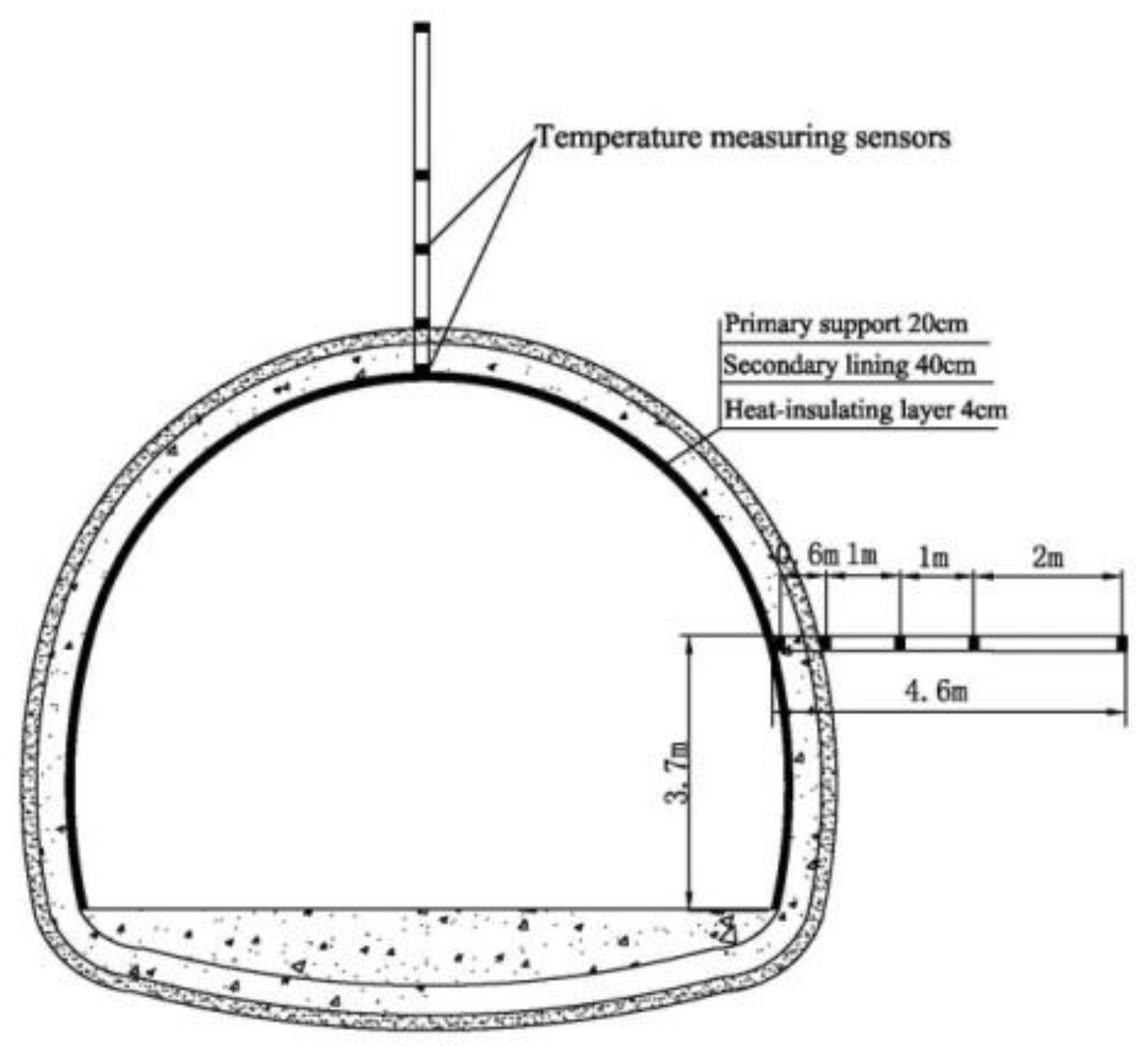
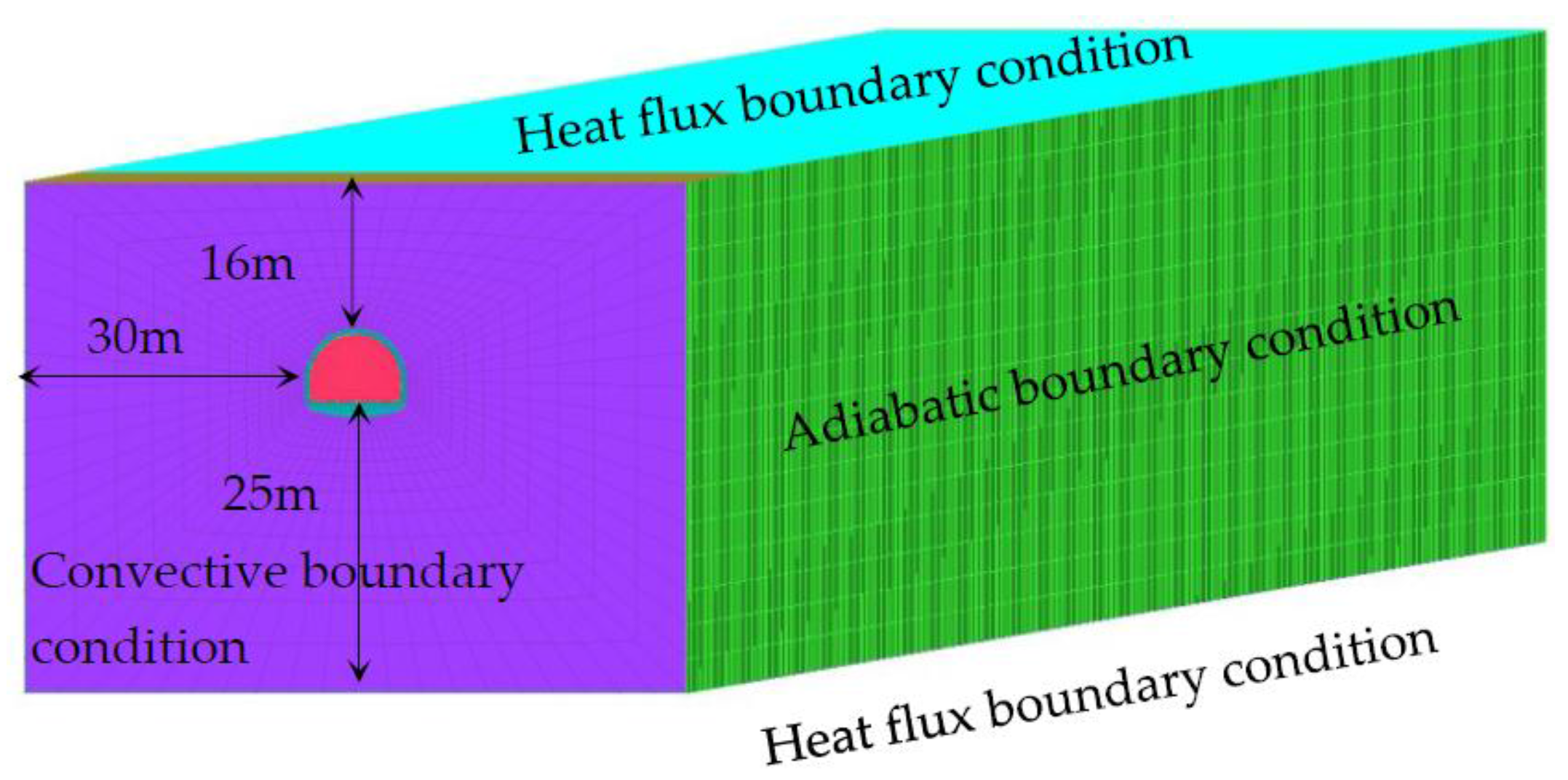
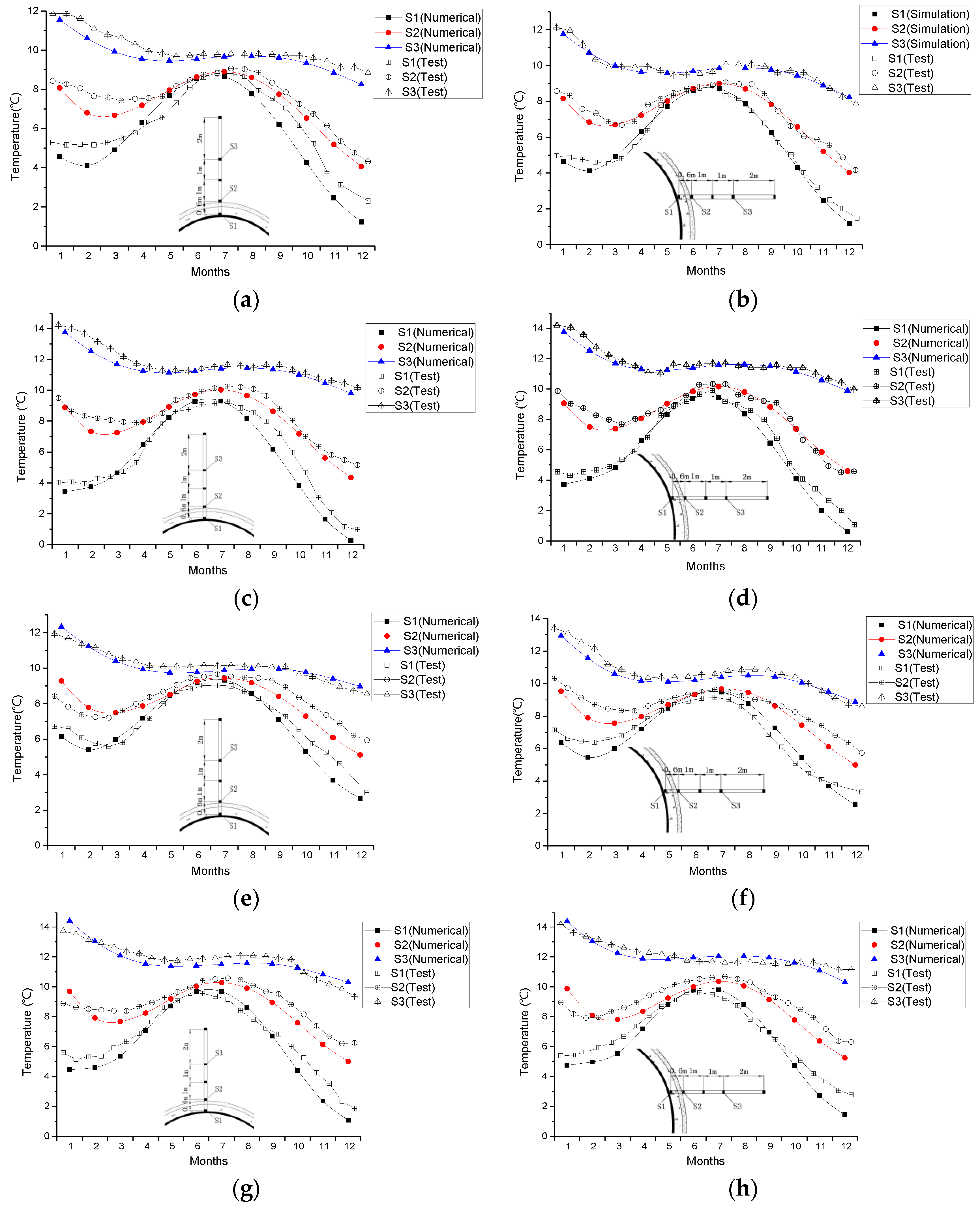
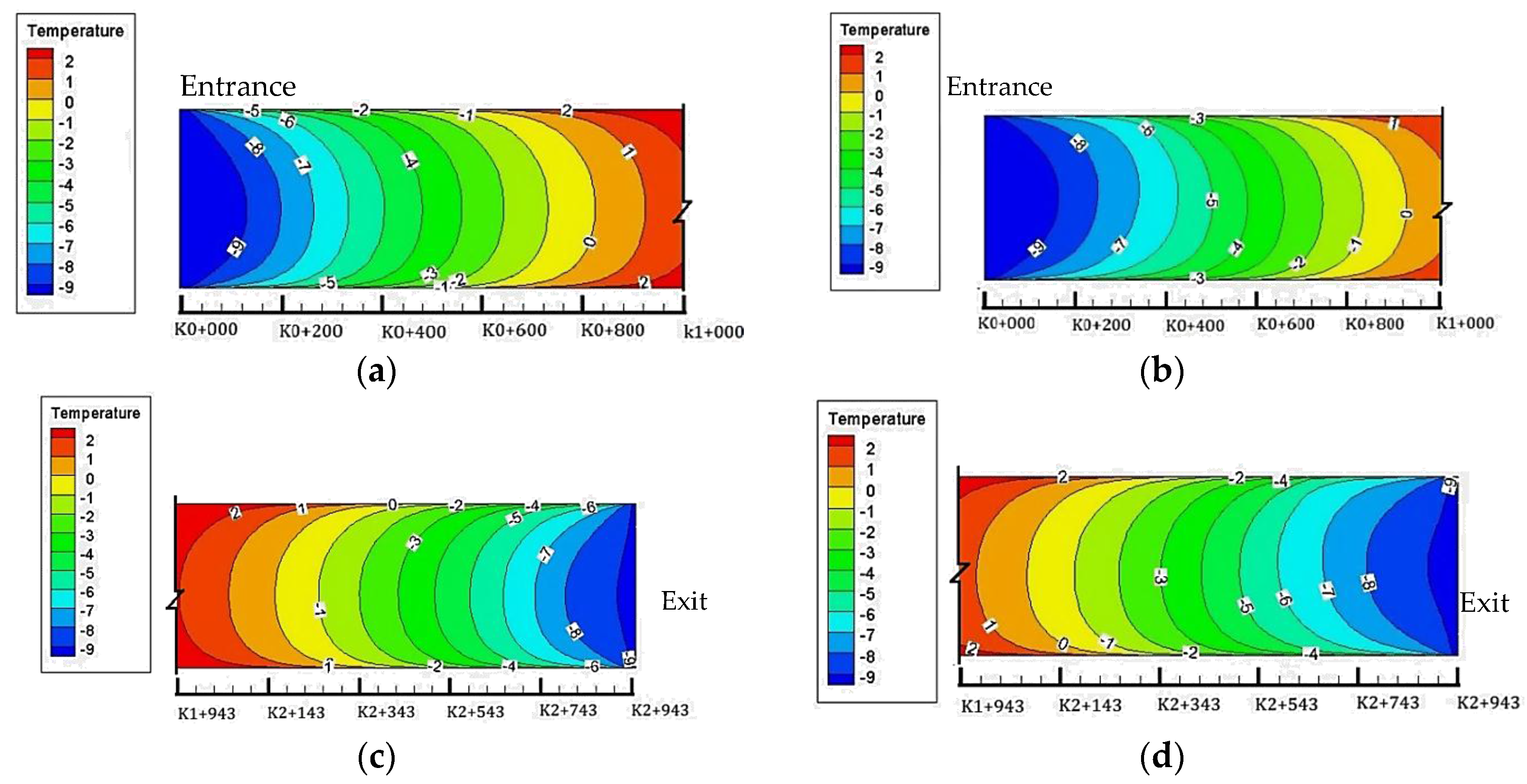
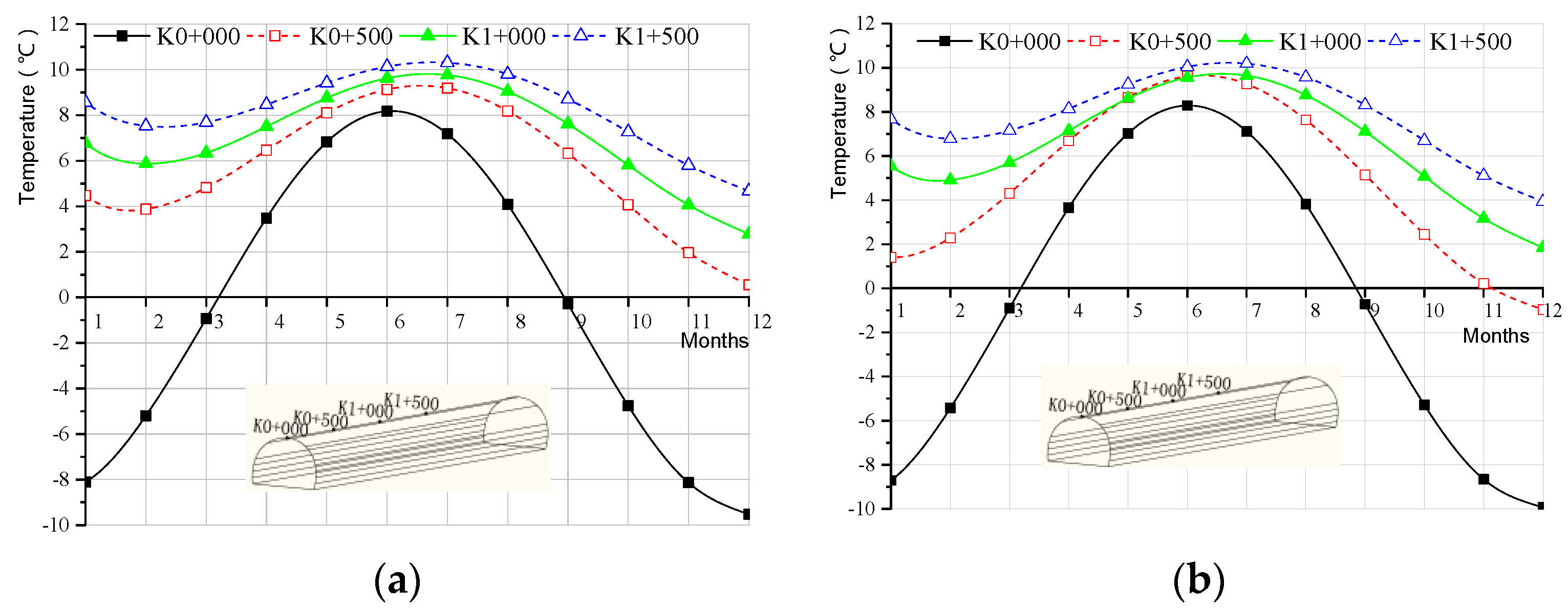
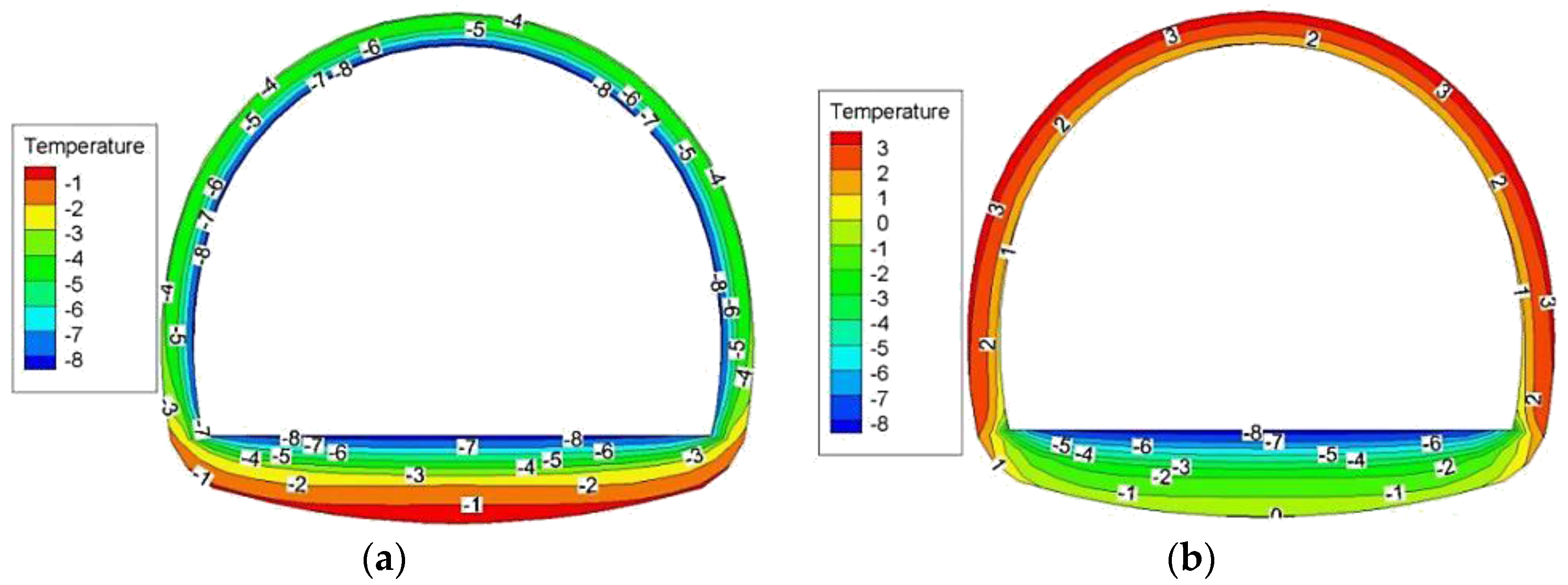

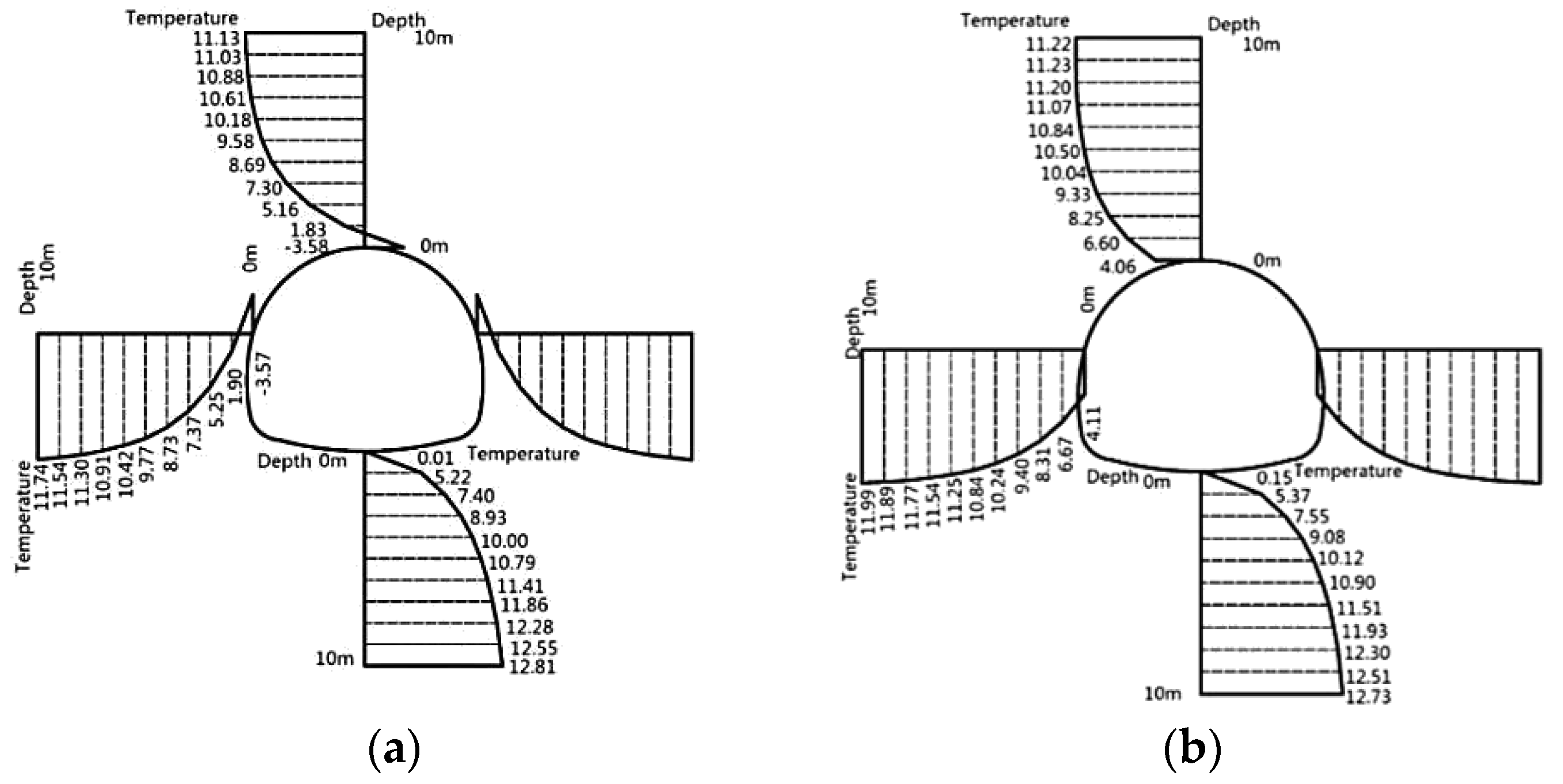
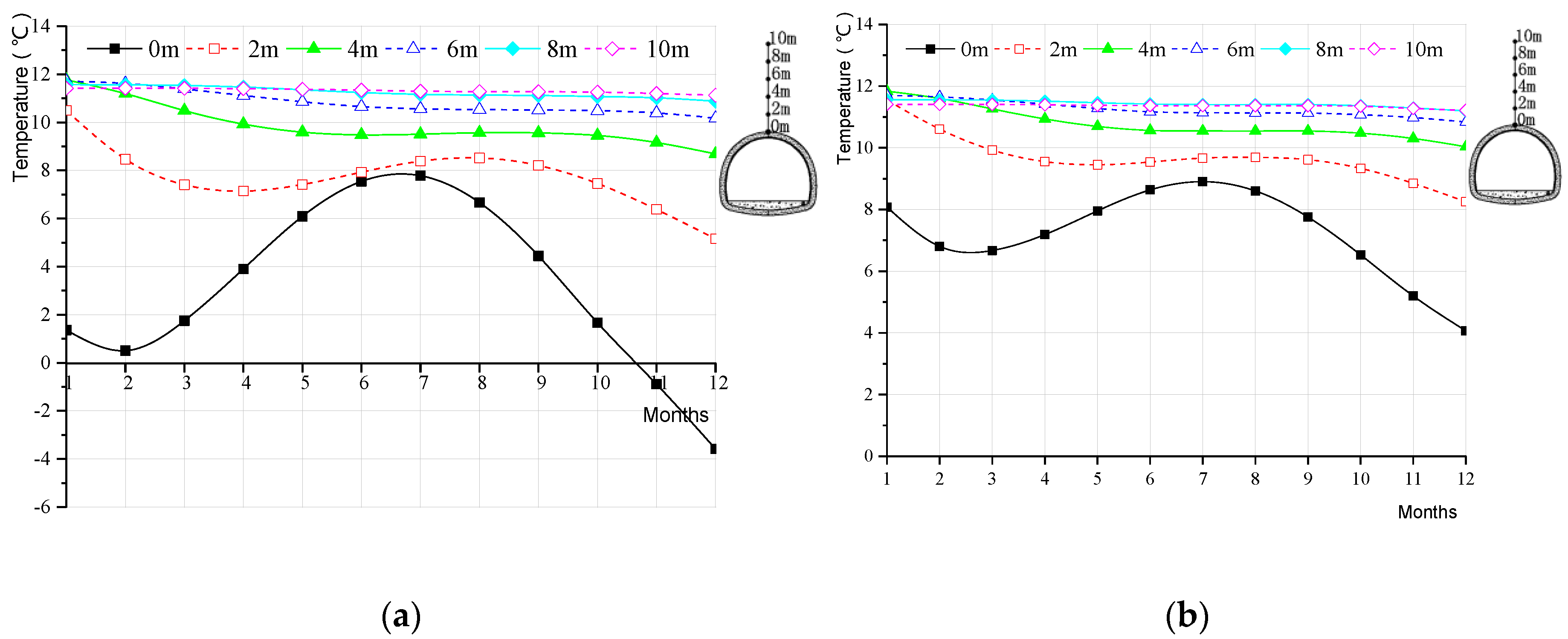
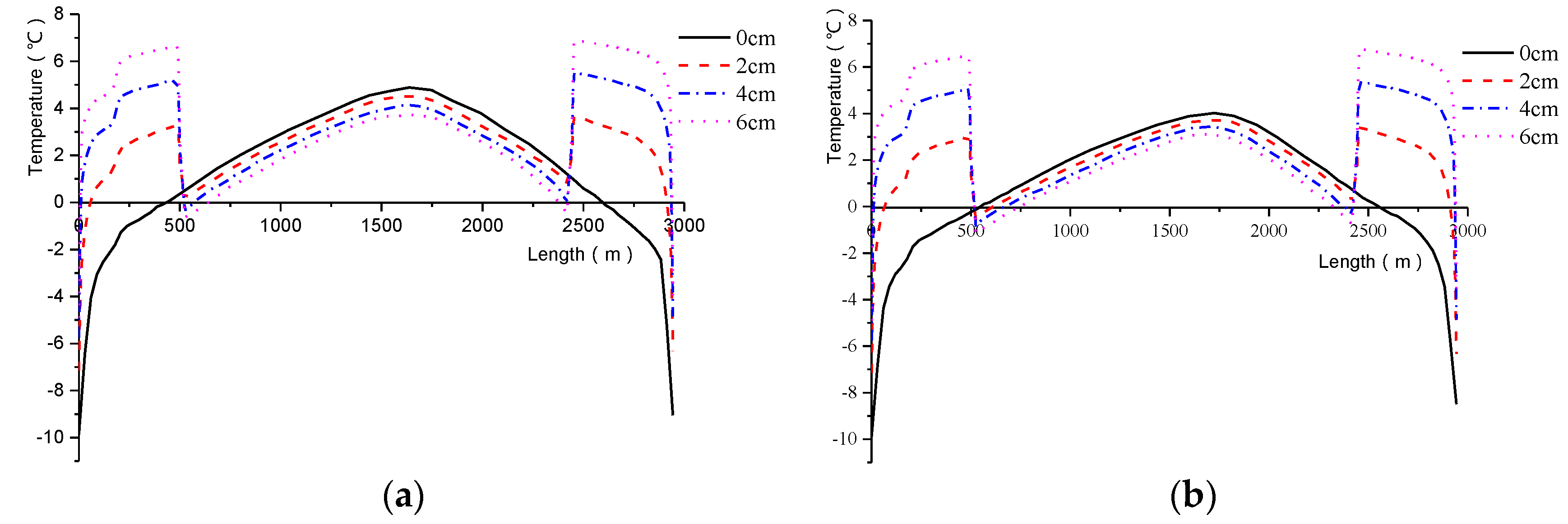

| Material | Density (kg/m3) | Heat Capacity (Unfrozen Zone) (J/kg∙°C) | Heat Capacity (Frozen Zone) (J/kg∙°C) | Thermal Conductivity (Unfrozen Zone) (w/m∙°C) | Thermal Conductivity (Frozen Zone) (w/m∙°C) |
|---|---|---|---|---|---|
| Surrounding rock | 2450 | 1178 | 896 | 1.91 | 2.77 |
| Concrete material | 2385 | 970 | 970 | 1 | 1 |
| FLOLIC | 60 | 230 | 230 | 0.024 | 0.024 |
| Material Type | Density (kg/m3) | Heat Capacity (Unfrozen Zone) (J/kg∙°C) | Heat Capacity (Frozen Zone) (J/kg∙°C) | Conductivity (Unfrozen Zone) (w/m∙°C) | Conductivity (Frozen Zone) (w/m∙°C) |
|---|---|---|---|---|---|
| Polyurethane | 45 | 185 | 185 | 0.027 | 0.027 |
| Stem method aluminosilicate sheet | 188 | 320 | 320 | 0.038 | 0.038 |
| Material Type | Covering Section | Different Thickness for Insulating Layer (cm) | Lining Length in Negative Temperature at Tunnel Ends (m) | Reasonable Thicknesses (cm) |
|---|---|---|---|---|
| FLOLIC | Entrance | 2 | 55 | 4 |
| 4 | 0 | |||
| 6 | 0 | |||
| Exit | 2 | 31 | 4 | |
| 4 | 0 | |||
| 6 | 0 | |||
| Polyurethane | Entrance | 2 | 78 | 6 |
| 4 | 21 | |||
| 6 | 0 | |||
| Exit | 2 | 49 | 6 | |
| 4 | 18 | |||
| 6 | 0 | |||
| Stem method aluminosilicate sheet | Entrance | 2 | 94 | 6 |
| 4 | 47 | |||
| 6 | 0 | |||
| Exit | 2 | 52 | 6 | |
| 4 | 29 | |||
| 6 | 0 |
| Material Type | Covering Section | Different Lengths (m) for Insulating Layer with Certain Thickness | Lining Length in Negative Temperature at the End of Insulating Layer (m) | Reasonable Lengths (m) |
|---|---|---|---|---|
| FLOLIC | Entrance | 500 (4 cm thickness) | 74 | 700 |
| 600 (4 cm thickness) | 25 | |||
| 700 (4 cm thickness) | 0 | |||
| Exit | 500 (4 cm thickness) | 52 | 600 | |
| 600 (4 cm thickness) | 0 | |||
| 700 (4 cm thickness) | 0 | |||
| Polyurethane | Entrance | 600 (6 cm thickness) | 85 | 800 |
| 700 (6 cm thickness) | 37 | |||
| 800 (6 cm thickness) | 0 | |||
| Exit | 600 (6 cm thickness) | 48 | 700 | |
| 700 (6 cm thickness) | 0 | |||
| 800 (6 cm thickness) | 0 | |||
| Stem method aluminosilicate sheet | Entrance | 600 (6 cm thickness) | 33 | 700 |
| 700 (6 cm thickness) | 0 | |||
| 800 (6 cm thickness) | 0 | |||
| Exit | 600 (6 cm thickness) | 17 | 600 | |
| 700 (6 cm thickness) | 0 | |||
| 800 (6 cm thickness) | 0 |
© 2017 by the authors. Licensee MDPI, Basel, Switzerland. This article is an open access article distributed under the terms and conditions of the Creative Commons Attribution (CC BY) license (http://creativecommons.org/licenses/by/4.0/).
Share and Cite
Yan, Q.; Li, B.; Zhang, Y.; Yan, J.; Zhang, C. Numerical Investigation of Heat-Insulating Layers in a Cold Region Tunnel, Taking into Account Airflow and Heat Transfer. Appl. Sci. 2017, 7, 679. https://doi.org/10.3390/app7070679
Yan Q, Li B, Zhang Y, Yan J, Zhang C. Numerical Investigation of Heat-Insulating Layers in a Cold Region Tunnel, Taking into Account Airflow and Heat Transfer. Applied Sciences. 2017; 7(7):679. https://doi.org/10.3390/app7070679
Chicago/Turabian StyleYan, Qixiang, Binjia Li, Yanyang Zhang, Jian Yan, and Chuan Zhang. 2017. "Numerical Investigation of Heat-Insulating Layers in a Cold Region Tunnel, Taking into Account Airflow and Heat Transfer" Applied Sciences 7, no. 7: 679. https://doi.org/10.3390/app7070679






